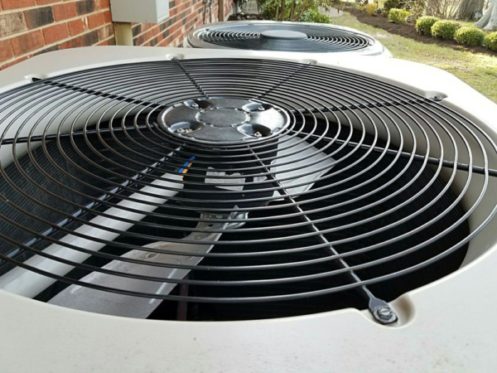The summers in Missouri tend to be extremely hot and muggy, and this can create issues with high indoor humidity. If your AC unit is the proper size and working correctly, it should be able to control your home’s humidity level on its own. Nonetheless, there are many times when this doesn’t happen and the indoor humidity level remains too high despite the AC maintaining a consistent indoor temperature. One possible solution to this issue could be adjusting the speed of your blower fan. To help you better understand how this works, let’s now take a look at airflow rates and the effect that AC fan speed can have on indoor humidity.
Understanding Airflow Rates
Your air conditioning system needs to move a certain volume of air in order to cool effectively. If the airflow is too high or too low, it can create various issues that will impact indoor temperature and humidity. Airflow is measured in cubic feet per minute (CFM). The general rule of thumb is that you need between 350 and 400 CFM of airflow for each AC ton. This means that if you have a 2-ton AC unit, the airflow should be between 700 and 800 CFM. For a 5-ton AC, you’ll need 1,750 and 2,000 CFM.
If the airflow rate is below 350 CFM, it can quickly cause the evaporator coil to freeze up. This occurs because there isn’t enough volume of hot air flowing over the coil. When this happens, the refrigerant stays too cold, and this allows the condensation on the coil to freeze. If the airflow rate is too high, it can have a major effect on the system’s performance and usually results in much higher indoor humidity. Both of these problems put added stress on the AC system and can potentially damage the compressor motor or cause it to overheat.
The airflow rate is determined by the speed of the blower fan inside your air handler. Unfortunately, it is not something that you can measure on your own as it requires very specific equipment and knowledge. This means that you will need to hire an AC technician to measure your airflow if you suspect it is too high or too low.
The Link Between Fan Speed and Indoor Humidity
The normal factory setting for blower fans is 400 CFM per ton. This is the setting that is recommended for use in drier climates. However, in more humid climates like Missouri, your fan speed should really be set at 350 CFM.
The higher the fan speed is, the more volume of air it will move at one time. This results in the AC cooling the house down more quickly due to the increased volume of cold air being circulated every minute the system runs. While this may sound like a good thing, and in some cases it is, it can have a major impact on indoor humidity.
When your AC runs, it absorbs both heat and moisture from the air inside your home. The higher the fan speed is, the less time it will take for the AC to cool your home to the desired temperature. This obviously has an impact on how much moisture the system can remove from the air. If the AC only runs for a few minutes before shutting off again, it will obviously remove less moisture than if the fan speed was lower and the system ran for longer.
This is one of the major reasons why variable-speed AC units are so much more effective at managing indoor humidity. These units can reduce the speed of the AC compressor motor, which will slow down the rate of cooling and allow the system to remove more moisture. If you’re looking to replace your old air conditioner, a variable-speed AC is definitely the best choice for humid climates. Nonetheless, you may be able to achieve a similar effect by having an AC technician reduce the speed of your blower fan if it is set too high.
How Does an AC Technician Adjust Fan Speed?
Some HVAC systems have a variable-speed fan motor, in which case you won’t need to worry about adjusting the fan. However, most systems use a single-speed fan. Even though the fan only ever runs at one speed, you can still adjust this speed to be faster or slower.
Most blower fans have three different speed settings: high, medium and low. When your system was installed, there is a good chance that the fan speed was set to high. If so, changing it to the medium setting may help reduce your high humidity issues by allowing the system to run for longer periods of time. Again, this is something that you will definitely need to hire a professional to change as otherwise you could potentially ruin the fan motor.
There is a separate wire for each speed setting, but only one of these wires is ever attached to the fan relay terminal. These three wires are always color-coded to allow the technician to determine which wire corresponds to which speed. The issue is that basically every AC manufacturer uses a different color-coding system. If you don’t know which wire is which and connect the wrong one, it can negatively impact the system’s performance and potentially damage the fan motor.
To change the fan speed, a technician will first need to flip the AC circuit breaker to shut off the electricity to the fan motor. They will then disconnect the high-speed wire from the terminal and secure it with a wire nut to prevent short-circuiting. Next, the technician will strip the end of the wire and then connect it to the terminal in place of the high-speed wire. The last step is to turn the power back on and then test the system.
As soon as the system turns back on, you should be able to hear that the fan speed is lower. You will also quickly notice that your AC now runs for longer at one time than it did before.
Other Issues That Can Contribute to High Indoor Humidity
Fan speed is not the only issue that can cause your AC to fail to manage your home’s humidity. One of the most common issues is that the AC is oversized. If your AC unit is bigger than your house needs, it will cool the home much too quickly to ever make a difference in the indoor humidity level. It could also be that your ductwork is either not the correct size, poorly designed or improperly installed.
We also regularly run into situations where high indoor humidity is caused by having the fan set to “On” instead of “Auto.” When your AC is on, you should always leave the fan set to Auto. When your system shuts off, there is still a large amount of condensation on the evaporator coil. If the fan continues to run when the AC condenser is off, the warmer air blowing over the wet coil will absorb the moisture. This can greatly raise the humidity of the air blowing out of your vents.
Professional AC Maintenance and Repairs
If your AC is struggling to manage your home’s humidity, Level 9 Heating, Cooling, and Plumbing is here for you. Our certified technicians can check your fan speed, ductwork, AC size and other factors to determine why your humidity level is high. We can then make any necessary adjustments or repairs to improve the efficiency and effectiveness of your AC system. Our technicians also specialize in installing whole-home dehumidifiers in Washington and the surrounding areas, and this is often the best solution for overcoming high indoor humidity. For more information on AC fan speed or the ways you can manage your home’s humidity level, give us a call today. We also offer heating and geothermal services.



